2021-01-02
From first Greens senator to first Greens owned office
By Chilla Bulbeck, member of Greens history group
Introduction
The Greens (WA) turned 30 on 1 January 2020, and finally found the right post-Covid time to celebrate in December this year. More to the long-term point, we are ‘celebrating’ our history with 52 interviews of our long-standing members and all our politicians who agreed to be interviewed. The transcribed interviews are being professionally prepared for deposit in the Battye Library. We have also archived around 300 items, including Greens t-shirts, election material, GWA merger negotiation documents. For all of this, we owe immense thanks to David Worth, convenor of our informal Greens history group, who has undertaken the bulk of the interviews and document selection and archiving. He has been intermittently assisted by Giz Watson, Anne Yardley, Annabelle Newbury and Jennie Carter.
Our next step will be to place some interviews on our website, for your perusal, comment and contribution of your own Greens (WA) history memories.
Below is a short history of the Greens (WA), drawn largely from the newsletter Green Issue (GI). Green Issue has evolved over the years: edited first by office bearers and later a working group; initially hosting many letters and differences of opinion, later more often dedicated to particular themes; in the beginning published monthly, later moving to five or six times a year. Green Issue was increasingly distributed by email attachment once this option became available, although to this day 19 copies are still posted to members. From April 2016 Green Issue was published online and advertised on the GWA website.
For more, or even less of our history than that below, visit the website: https://greens.org.au/wa/about/our-history
In the beginning
Once upon a time there was no Greens (WA). There was a party called the ‘WA Green Party’, the only political party that could call itself ‘Green’ on the ballot paper. There was also a senator, Jo Vallentine, willing to become a Greens senator if various almost like-minded progressive movements could come to a merger agreement.
On 1 January 1990 the Greens (WA) were created when the Green Earth Alliance, representing the Alternative Coalition Inc, Vallentine Peace Group and ‘certain supporters’ of Green Development merged with the WA Green Party by adopting the Constitution of The Greens (WA) in the Sunken Gardens at The University of Western Australia. The agreement was signed by 11 office bearers and key signatories of these groups. A further 115 witnesses signed as ‘those present’.
The parties were spurred by the likelihood of a federal election, which was indeed called for 24 March 1990. Jo Vallentine polled the highest Greens vote in the nation, 8.33 per cent of the primary vote, and won her seat on preferences. She was the first Greens senator in Australia (not Bob Brown!). Jo ran on the first ever all female senate ticket with running mates Christabel Bridge (later Chamarette who completed Jo’s term) and Gladys Yarran (the first Indigenous woman to run for the senate) (Manning, Inside the Greens p87).
An enduring structure
The original Constitution laid out the structure we are familiar with today. Grassroots Electoral Councils (now called Regional Groups) would send rotating representatives to the decision-making Representatives Council. An Election Campaign Committee was also created as was a Quick Decision Making Group and a number of working groups.
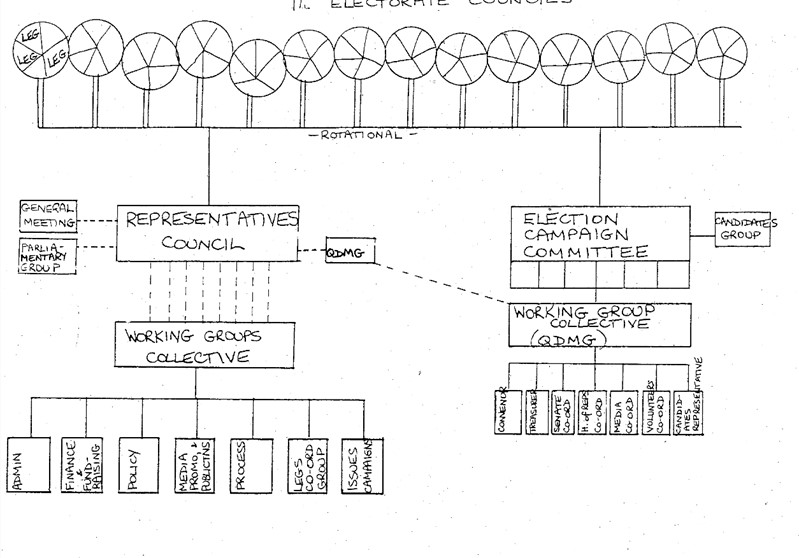
The chart above shows several groups that have existed since GWA formed. Administration Working Group, convened by the GWA co-convenors, ensures the smooth running of Greens (WA) and removes some trivial decision-making from Representatives Council (not enough according to some permanent reps!). Policy Working Group ensures that all Greens members who wish to can participate in polishing our policies before election campaigns. Two long-serving convenors were Cameron Poustie and Mark Cooper.
The Election Campaign Committee (ECC) once morphed from FECC to SECC and back again, as it oversaw Federal and then State election campaigns. It is now a standing committee, supported by the work of the Candidate Assessment Group (CAG) which scrutinises all candidate applications very carefully to avoid any more dual citizenship and other surprises. Trish Cowcher has played a key role as convenor of ECC and now CAG. Each electoral region has its returning officer who ensures that candidate selection is done according to the party’s rules. Long-time returning officer, Scott Ryan has also trained additional returning officers. Only once in our history did we achieve more than the quota needed to elect our political candidate. Preferences Working Group is thus the final essential nail in an election campaign, securing the extra votes needed to win seats. Luke Edmonds as the key and canny preferences negotiator has kept open channels of communication with other parties for many years.
Growing professionalism in campaigning has been achieved since 2013 by Jess McColl, Andrew Beaton and Sophie Greer as campaign managers and field directors. Generally, our campaign fundraising has also grown, supporting larger campaign teams to strategize, plan, co-ordinate, train, enthuse and evaluate.
For example, the 2016 Federal election campaign which morphed into the 2017 State election campaign was led by Andrew Beaton, Campaign Manager, and Sophie Greer as Field Director. Other staff included Elliot Sawers, Booth Coordinator (letting them have cake he baked every day) supported by Giz Watson, Annabelle Newbury, Jo Vallentine and Graham Ludlam. Jordon Steele-John was the Volunteer Engagement Officer. Sarah George pioneered the new role of Outreach Coordinator. The IT team, led by Peter Condon, included Anthony Blond, Grahame Bowland and other regular IT support staff.
Across the decade from 2010, Greens (WA) campaigns developed ever more sophisticated door-knocking, telephone banking and other targeted voter contact. The table below charts the trend of growing volunteer engagement which builds community understanding of the Greens (WA) and expands our campaigning capabilities, whatever the election outcome.

*20% more than Federal 2013
**For 2017: The figure of 74,439 voter contacts found at one location was allocated according to another set of data showing the split between door knockers and phone bankers
Other Greens (WA) working groups change over the years with changing political issues and members’ energy. These have included Greens Refugee Action Group, Unions and Industrial Relations Working Group, and the Young Greens formed to engage the growing number of younger members in campus recruitment and door-knocking field trips.
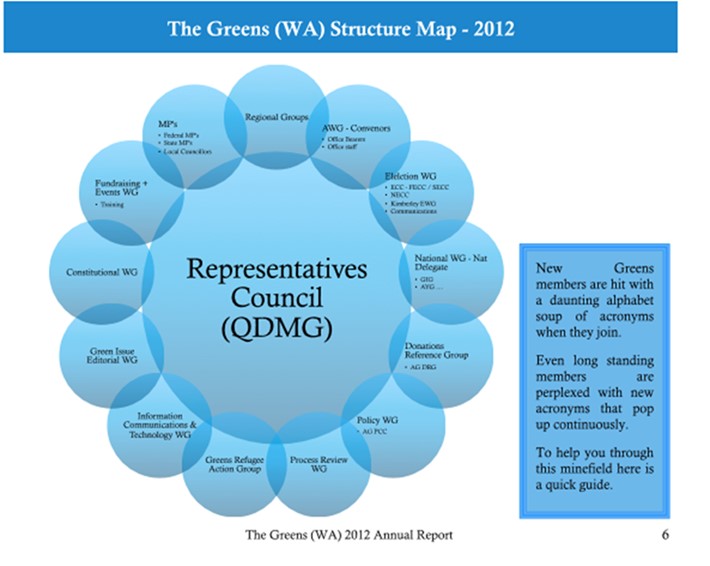
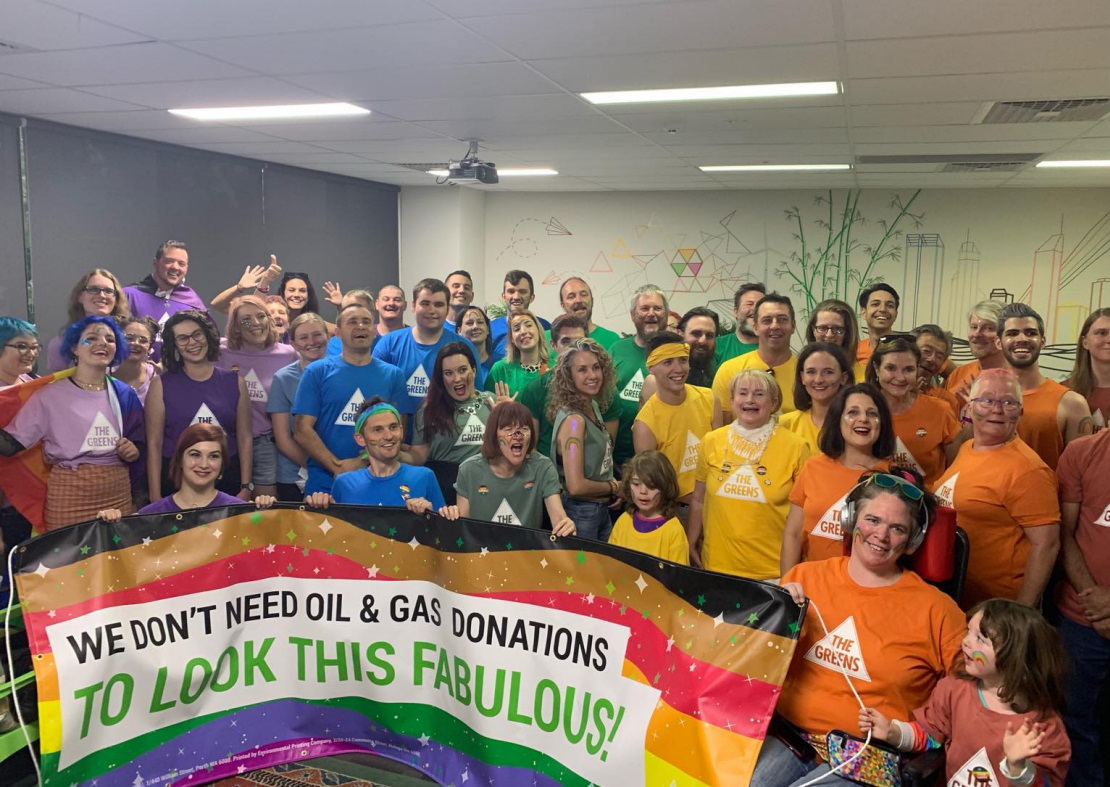
An enduring and colourful group is Pride Working Group.
Our politicians
Jo Vallentine, the Greens trailblazer in federal parliament, paved the way for WA to regularly ‘punch above our weight’, usually electing two senators. New South Wales and Queensland have only ever had one sitting senator and the other states achieved two later than Greens (WA). As the timeline below shows, when Dee Margetts lost her senate seat in 1999, WA had no senator from WA until Rachel Siewert was elected in 2004.
Over our thirty years, 380 Greens members have contested at least one seat in a state or federal election. The successful candidates have become four senators, nine MLCs and one MLA. The record for being a ‘serial candidate’ is held by Robin Chapple, standing for parliament 11 times, followed by Giz Watson at 10 times. Rachel Siewert holds the record for longest service at 17+ years. Dorinda Cox as the first Indigenous candidate to run for a winnable seat, at the next federal election.
The timeline below summarizes our politicians’ service, never falling to zero and rising very briefly in 2009-2010 to two senators, 4 MLCs and one lower house member, Adele Carles.

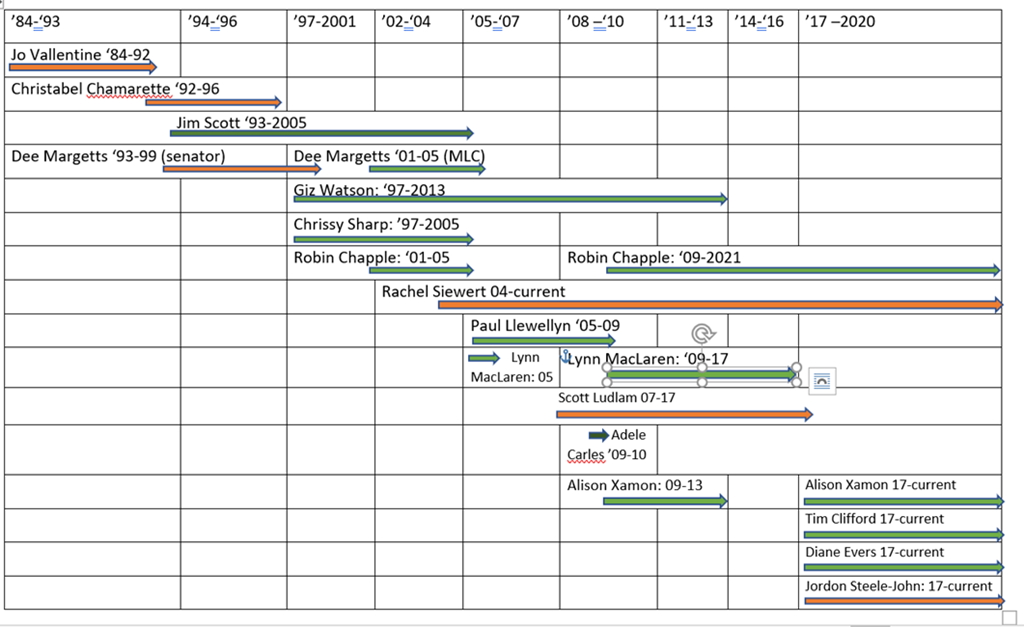
A home of one’s own
Once upon a time, the Greens (WA) had no office, no telephone number and certainly no email address. The Party commenced its life with ‘2 desks, 6 chairs, 2 photocopiers, partitions and shelving, printed bumper stickers’. These were ‘assets not subject to any claim’ provided by The W.A. Green Party, who also brought a financial debt to the merger. Initially Greens (WA) had only a post office box. The party relied on office bearers for storage space, working space and their personal telephone numbers were listed as the Greens (WA) number (GI, July, 1991, p2).
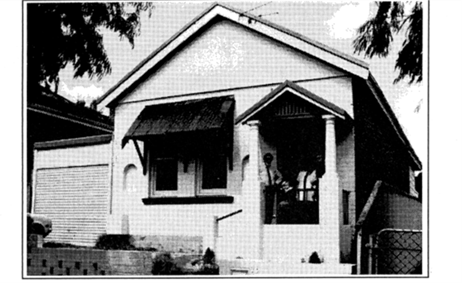
The first Greens office opened in April 1992, at 45 Wickham Street, East Perth, and was funded by a pledge system (the forerunner of Greenscheme) (GI, Apr, 1992, p4). To become an office, this three bedroom ‘derelict house’, as some early members remember it, required office furniture and equipment (including both an IBM and Mac computer), library resources and ‘exciting creative toys’ to entertain children during meetings, as well as volunteers to staff the office and improve the garden (GI, Jun, 1992, p5).
Further pledges to pay the rent were called for throughout 1992 and 1994, but the party’s vision had exceeded its grasp. Around April 1994, the Wickham Street house was abandoned for a small section of a driving school, really only a single large room, at 16 Wickham Street.
In August 1997 the office moved to 4/439-441 Albany Highway, a small upstairs office of approximately 70sqm. In April 2004, Green Issue excitedly announced, ‘In the most important move since (insert transition dear to you) the Greens (WA) have left Victoria Park for the City. No longer stuck in the suburbs, we now work at our goal of Doing Politics Differently from the comfortable surrounds of the CBD. … closer to Parliament House, three of our Pollies’ offices and a large range of good coffee shops’.
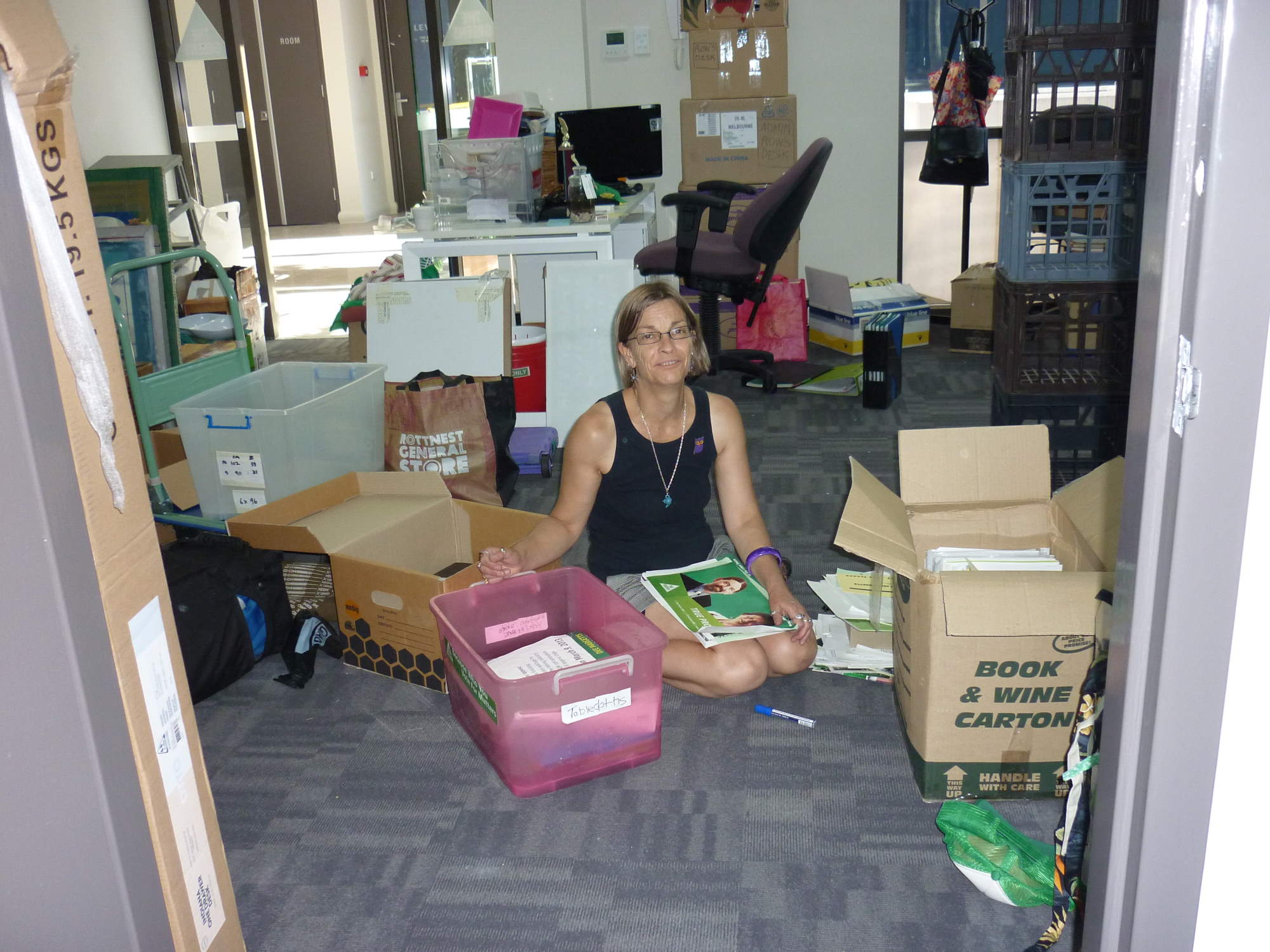
After the Senate by-election in 2014, we had outgrown 445 Hay Street. We moved to 440 William Street, in February 2016, with Bel Meddings’, Administration Working Group member, perseverance finally paying off. We now had our own balcony, windows with a view (except they had Greens signs stuck in them) and a welcoming (but heavy) sign, rolled out and in by Sophie Greer every day.
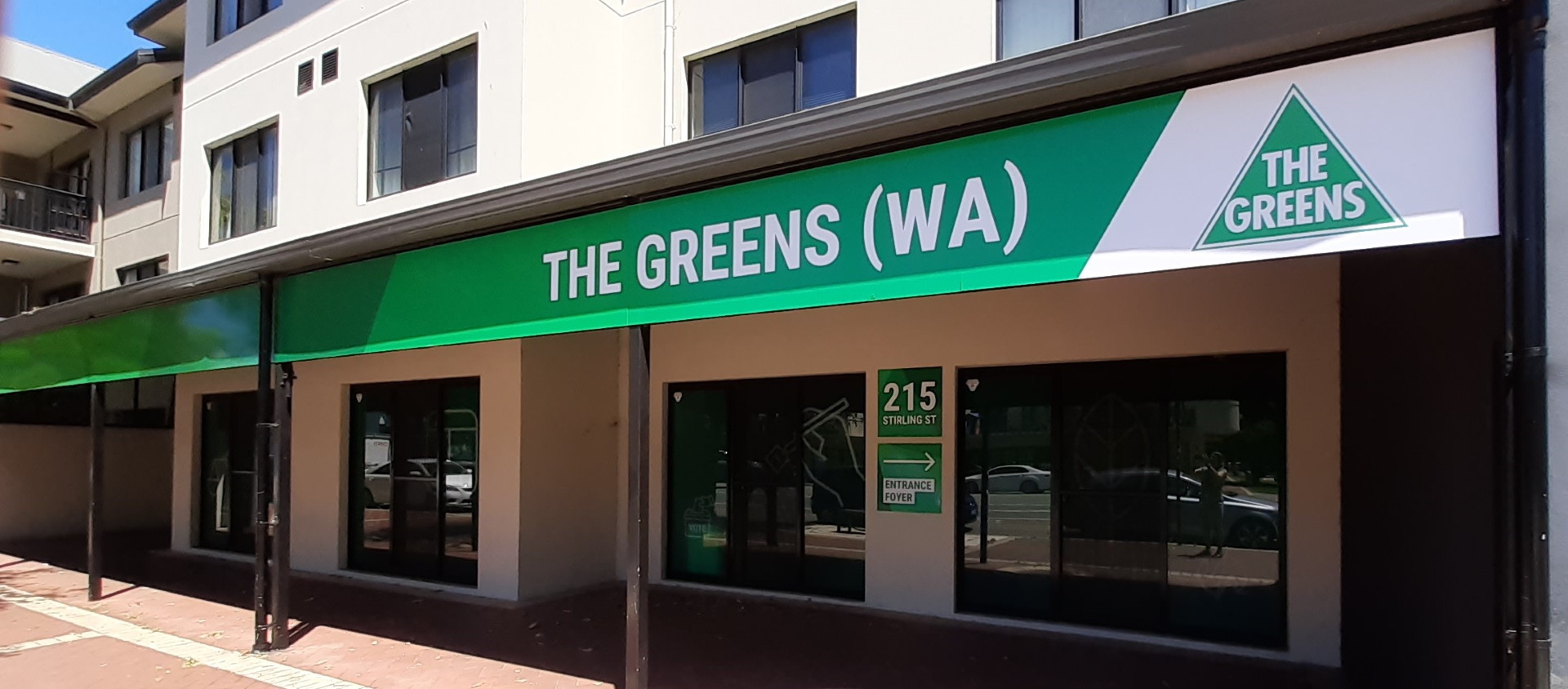
In December 2014, the Donor Relations Working Group launched the Future Fund to coincide with the celebration of 30 years since Jo Vallentine’s first election to parliament. The Fund received over 120 donations in amounts ranging from $5 to over $500,000. In 2017, we lost ‘our longest serving office volunteer, friend and stalwart supporter of the Greens, Jay Birnbrauer. Jay left us an extremely generous gift from his estate (Peace, love and chocolate Jay, wherever you are!)’ (Co-convenors, Annual Report 2018). In 2019 the directors allocated $800,000 to achieve a Future Fund objective of purchasing an office. Luke Edmonds and Rowena Skinner surveyed potential offices near and not so close. Around October 2019, we found our own permanent home at unit 91/215 Stirling Street, Perth with reception, three offices, a meeting room, barbecue, swimming pool, a light-flooded kitchen and a long Green-adorned façade.
Staffing the office
The new Greens office, opened in 1992, was staffed with volunteers who filled an ambitious roster such as that for April 1992:
AM 9-1 PM 1-5
Monday Carole Perry Rowena Skinner
Tuesday Rob Tait Rowena Skinner
Wednesday Geoff Dodson Karl Haynes
Thursday Rob Tait Karl Haynes
Friday Coryn Keith Coryn Keith
Three years later, acting secretary Robert Tait noted in February 1996 that ‘our volunteer base [for staffing the office] is now close to non-existent’ (GI, Sep, 1995, p22). GWA launched a pledge campaign seeking 20 members pledging $20 each week to support the appointment of an office administrator (GI, Feb, 1996, p8).
The position was filled by Catherine Hall (GI, May,1996, p2) who served for 3 years, with a ‘friendly welcome’ and ‘contributed to election campaigns and activism tirelessly and with heartfelt commitment’(GI, Mar,1999, p14). The May Green Issue welcomed Celia Brooke as the new ‘voice on the end of the phone, holding the Greens office together’ (GI, May, 1999, p10). In March 2001 (GI, p10), the position of office coordinator was again advertised. Rowena Skinner was appointed, a position she holds to this day (GI, May, 2001, p7).
Over the years, the office experimented with various combinations of paid and volunteer roles to support the office administrator, with book-keeping and membership officer emerging as the enduring requirements. Paid and volunteer membership officers include Rosie Brookes, Rebecca Brown and Clare Nunan (2002-2005), Margo Beilby (2005-2011), David Letham (2011-2016), Jean le Quesne and Eddie Marynowicz (2016-present). Paid and volunteer book-keeping staff include Pat Gandini (1998 to 2005), Marcia Morgan, developing MYOB with Rowena (2005-2011), and Jenny Sullivan (Accounts Assistant) (2011 to present). Donna Matthews (bookkeeper) worked a few hours each month (2008-2015), followed by Briohny Robinson (2016 to circa 2018) and Brian Greer (2019-present).
In Green Issue September 2002 (p4), Rowena Skinner thanked the volunteers who assist in the office. Weekly volunteer hours, at 50, were in excess of the paid hours. Along with the membership officers, they continue to supplement the paid staff by 50 hours a week.
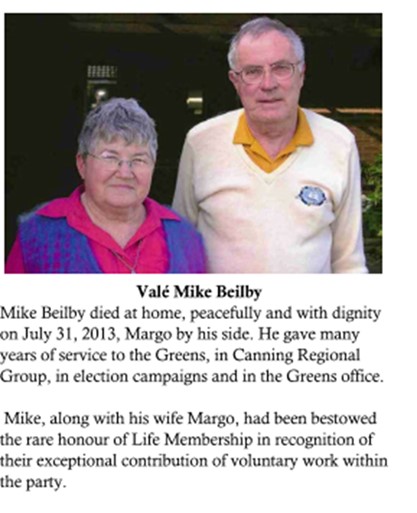
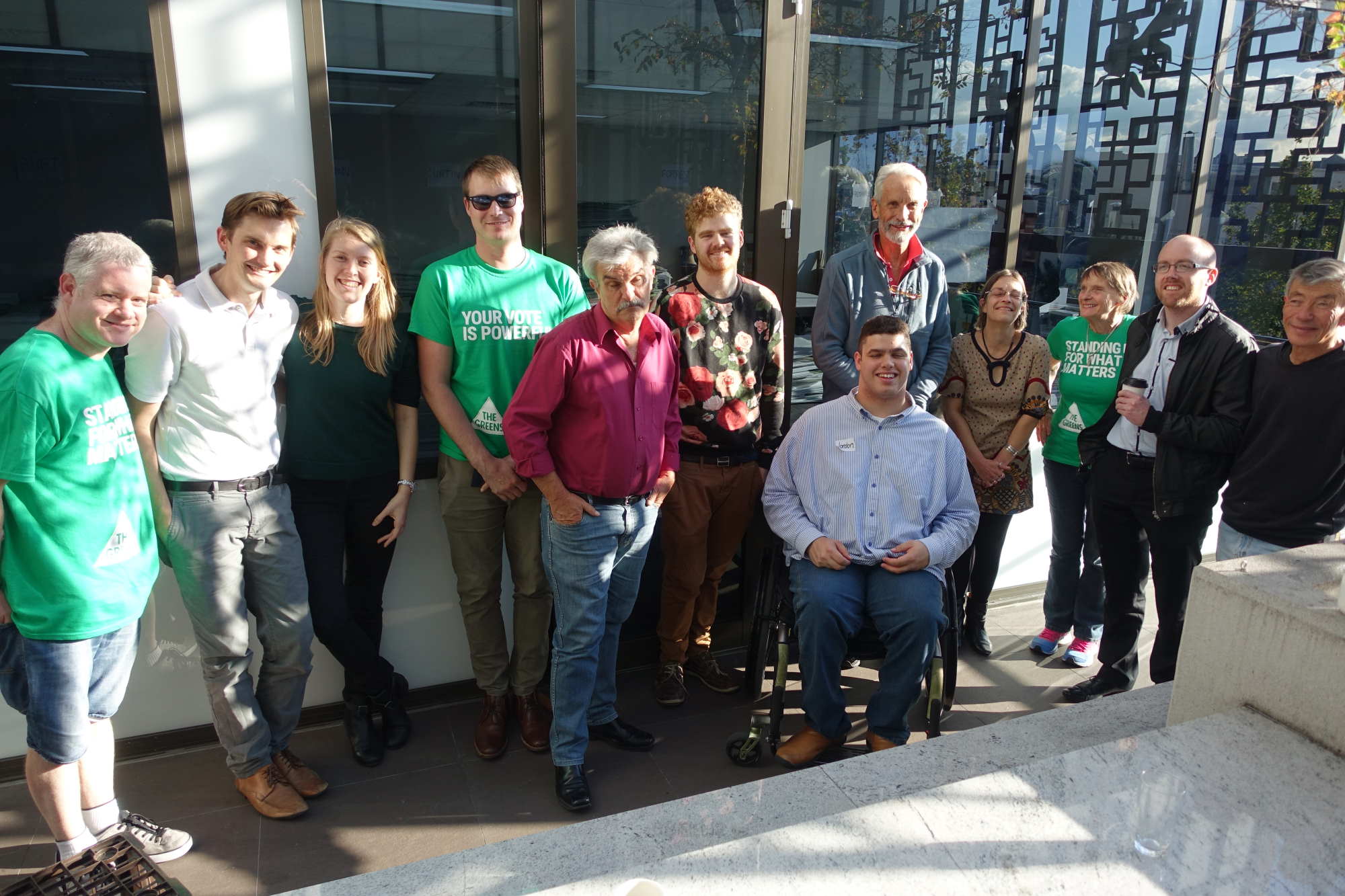
From party development manager to state director: 2011-present
Other experimental paid roles included Campaign Officer, IT Officer and Community Officer, all of which were terminated to fund a new position of Party Development Manager, Adrian Glamorgan commencing on 1 September 2011. The expectations attached to the role made for an unwieldy bundle and when the 2013 State election result halved the number of our MLCs and therefore their tithe contributions, the Annual Report in 2014 announced the Party’s ‘most difficult decision’. Adrian Glamorgan graciously resigned from GWA.
Sophie Greer had served as Field Director in the 2016 Federal Campaign and the 2017 State campaign. Sophie then won the new role of State Director of The Greens (WA). In that role, Sophie attended to potential liabilities for the party in areas like occupational health and safety and financial prudence, as well as reputational risks that come a progressive party’s way. She improved and streamlined the party’s administration, coordinated and supported volunteer work such as increasing membership engagement and retention, growing our regular income and improving volunteer experience. She worked hard to build and deliver synergies from improved collaboration between the state and federal politicians’ offices and the GWA office.
In the 2018 Annual Report, the co-convenors thanked Sophie Greer for unfaltering support, Rowena Skinner, the office manager and ‘key to all administrative knowledge’, and Jenny Sullivan, our book-keeper, as well as Rowena’s happy and hardworking team of volunteers, each of whom donates thousands of dollars of time to the Greens (WA) (Annual report 2018, co-convenors Matt Roberts and Chilla Bulbeck).
Going digital
From starting out as a party without even a telephone number, communication grew ever more digital over the years. In March 1997, the party acquired an email address: greenswa@argo.net.au (GI, Mar, 1997, p2). A so-called ‘home page’ website was acquired by April (GI, Apr, 1997, p2). By 2001, The Greens (WA) office email address was the address we have today. By contrast, the website and postal address have changed more than once in the intervening 20 years.
E-lists were established for different working and other groups, for example to debate policies or make quick decisions. Around 2016, loomio replaced decision-making by email for many Regional Groups. In 2018, we finally created a blended online and face-to-face Representatives Council Meeting platform (thank you Alan Perkins and David Letham). In 2020, when Covid hit, to the cheers of many remotely located members, Reps and other meetings went online through Zoom.
The Greens have led other parties in electronic communication as a means of campaigning. Party Development Manager, Adrian Glamorgan, during the 2013 state election campaign grew the Facebook page to 1600 likes, “outliking” the major parties: Labor at 1000 likes; Liberals at around 700 likes. Of all the goals in the 2014 Strategic Plan, increasing our digital footprint was the only one we achieved. Facebook likes rose to 16,864 in the 2017 campaign and today stand at 19,600 likes.
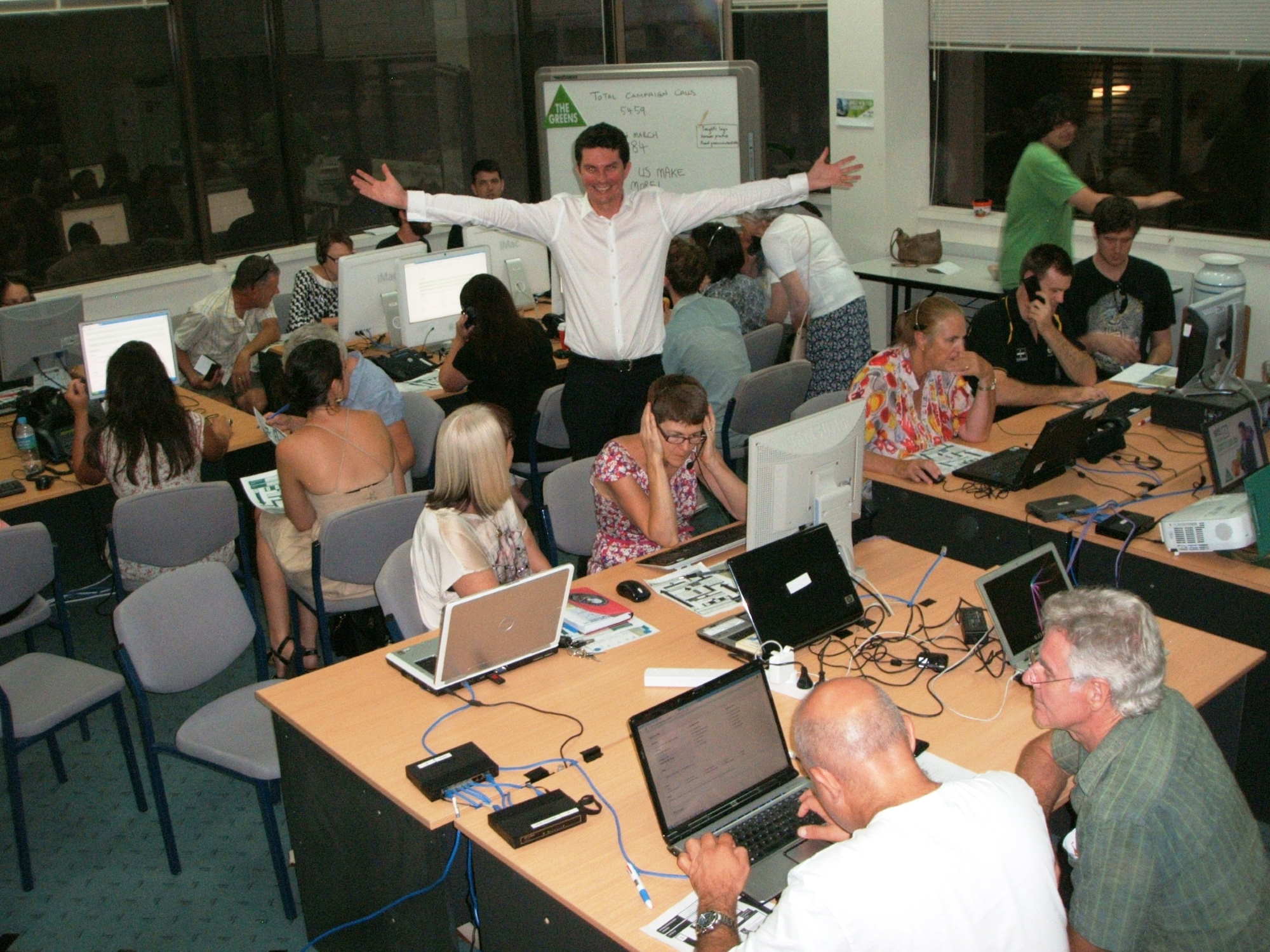
In 2016 Georgia Blackburn pioneered online voter conversion conversations, or digital door-knocking. By the 2019 election, ‘digital first’ or reaching voters through social media was a central element of campaigning. It undercut the stranglehold of the Murdoch media and responded to young people’s (and others’) increasing use of social media to obtain their news.
In the 2013 and 2014 State and Federal campaigns, ICT-WG volunteers, ‘reskinned’ the website, built a call centre for the federal by-election in 2014 trained volunteers in the use of the Civi-CRM database to fill booth rosters, door-knocking and leaflet drop records.
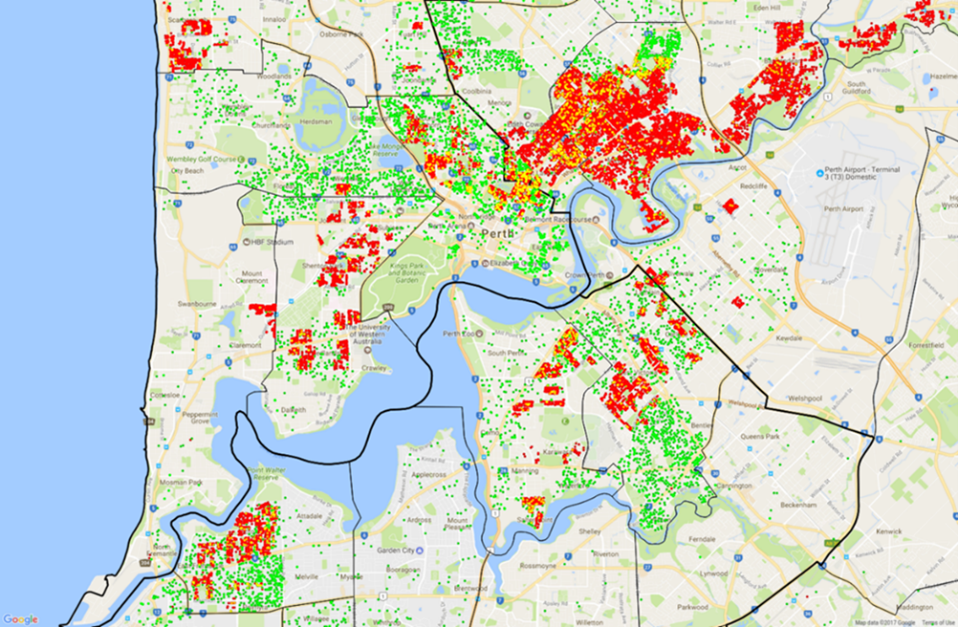
Grahame Bowland built a program, originally called EALGIS, which mapped polling booth votes from a point to a spatial array so that votes could be compared across elections and parties and, ultimately, with Australian Bureau of Statistics census data. Anthony Blond built a voter contact program, gVIRS, based on political parties’ access to electoral roll information. Both EALGIS and gVIRS were so innovative and powerful that the Australian Greens deployed the software to all constituent Greens parties.
Joining the Australian Greens
A national Greens party was formed in 1992, with the amalgamation of a dozen green groups, but Greens (WA) were not among them. A majority of members supported amalgamation in a survey undertaken in 1991 (GI, Sep, 1991, p7) , a ballot in 1992 (GI, Dec, 1992, p4), another ballot in 1999 (GI, Sep, 1999, p9) and a final successful ballot passing the 75% threshold in 2002 (GI, Nov, 2003, pp1-2).
The three issues holding WA Greens back were a belief that members of other political parties should not be allowed to be registered officers in the Greens (the fear being entryism by the DSP, Democratic Socialist Party) (GI, Sep, 1991, p7), a vocal minority’s conviction that the national constitution was ‘centralist and authoritarian’ (GI, Oct, 1992, p4) and a minor issue that GWA had allowed several stalwart early members of other political parties to be ‘associate’ members of GWA, a grandfathered clause that applied to a declining number of members.
In August 1996 Greens (WA) and the Australian Greens joined together in a formal alliance through which they attended each other’s meetings. Greens (WA) delegates attended national meetings and reported back at Representatives Council and other forums (GI, Jun,1994,p1).
In April 2002, the Greens (WA) Reps Council proposed another ballot, the timing later made more urgent by speculation concerning an early federal double dissolution election in 2003. An education and discussion campaign built on over six years of working with the national body produced an amalgamation in which the Australian Greens became a confederation, allowing Greens (WA) to join with the local autonomy members desired (GI, Nov, 2003, pp1-2).
Externally the big win was that the electorate across the nation is presented with a party operating under one name – the Australian Greens. In Western Australia, however, this was somewhat undermined because we used a different logo.
The great logo debate
The Greens (WA) logo for fifteen years consisted of minor variations on the ‘jam jar label’. Amalgamation encouraged consideration of adopting the national logo, the triangle (GI, May, 2003, p4). At the end of six months consultation, twenty draft designs and four separate informal ballots, the last of which narrowly supported the triangle, strong resistance at two consecutive Reps councils meetings overruled the ballot result and the jam jar label was retained.
Scott Ludlam’s graphic skills engineered a streamlined logo, on which he reflected: ‘On the positive front, … we can move on to more weighty matters like running spectacularly successful election campaigns and coming to grips with the worries of the world. Anyone who thinks an organisation’s graphic identity is a trivial matter should have come to the meetings!’ (Scott Ludlam, GI, Jun, 2004, p6).
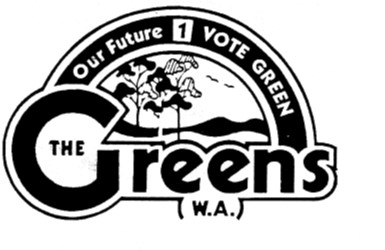
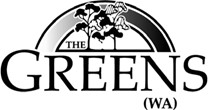
And so it was for five years, until, without comment between April and June of 2009, Green Issue moved to the triangle. Debate then raged concerning the correct shade of green and whether or not the ‘official’ logo was white or black lettering on a green background. More relaxed now, we happily proclaim our rainbow diversity in triangles of different colours.
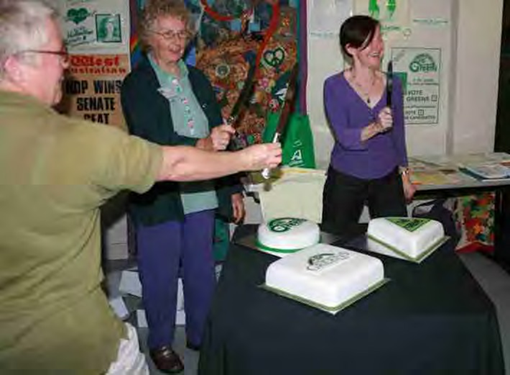
Growing the membership: a matter of life and death in 2000
Around half the members of the groups who founded the Greens (WA) left the new organisation, the original tally of 650 dropping to 335 by the end of 1993. A November 1993 report compiled by Kirsten Hawke et al. identified the attrition as due to structures that did not support consensus decision-making, felt particularly keenly by rural members; and lack of resource allocation for membership attraction and renewal campaigns, so that attrition was not compensated for by new members joining.
Attrition remains a problem, particularly at the one year mark. Members in 1998 recommended a questionnaire to find out what members want, making meetings more interesting and better run, perhaps with guest speakers, more social events, a redesigned membership form, and a contact person to follow up members who don’t rejoin or don’t attend meetings. A thankyou email to booth workers with an appeal to join, door-knocking to recruit members, leaflet drops, ads in local papers, stalls at fetes, field days and so on were suggested for recruitment (‘Dryandra Workshop Report’, reflecting after Federal election, Margo Beilby, GI, Dec, 1998, pp3-4).
In 2000, a new membership kit was promised for ‘membership building’, ‘on stalls and at fundraising events’ (Stewart Jackson, ‘Secretary’s Page (rave)’, GI, Feb, 2000, p8).
Saving the party by doubling the membership

On 3 October 2000, an amendment to the Electoral Act meant deregistration of parties with fewer than 500 members and no politician in Federal parliament. Deregistration was a serious threat, as Greens (WA) would lose the right to have the party’s name on the ballot paper, meaning a substantial drop in the Greens vote. All political parties were to submit the names of their members to the AEC in December 2000. The DLP challenged the legislation in the High Court and won their case. Another amendment to the Electoral Act proclaimed on 16 July 2001 gave the AEC the power to require the list of members’ names.
The Administration Working Group developed a recruitment strategy which included contacting all former members, distributing membership information to the large supporter base, adding membership forms to stalls kits, emphasizing the importance of new members, and reviewing the process of dealing with lapsed members. They also proposed sending membership information to all environment and progressive groups in WA (GI, Oct, 2000, p1).
The Greens (WA) then grew slowly to 1,000 members in 2008, hovering around here until 2013. In 2014, the membership reached 1,250 peaking at 1,400 in 2016, but then declining to 1,200 in 2018. Today membership is almost 1,700. Indicating membership churn, we also have 3,000 non-current members.
Federal elections attract new members, but many do not renew after their first year. The membership officers, both in the Greens (WA) office and in the regional groups, have worked on this, building membership with an increasingly streamlined membership renewal process, including default automatic renewal on the website, and a system of reminders including an email, a text message, a letter and, ideally, a personal phone call from the Regional Group’s Membership Officer. Membership engagement at the Regional Group level remains uneven, and a challenge for small groups. Moore-Cowan’s dramatic increase in participation demonstrates what an energetic, dedicated and savvy Membership Officer (Mary O’Byrne) can achieve.
The party held its first new members’ event in June 2014 with Jess McColl, as a member of Administration Working Group, coordinating the ‘how to be involved’ ‘new members’ kit with input from Giz Watson and Rowena Skinner. The event was immensely popular and finally we found the resources to run another successful new member event in July 2019.
Money, money, money ….
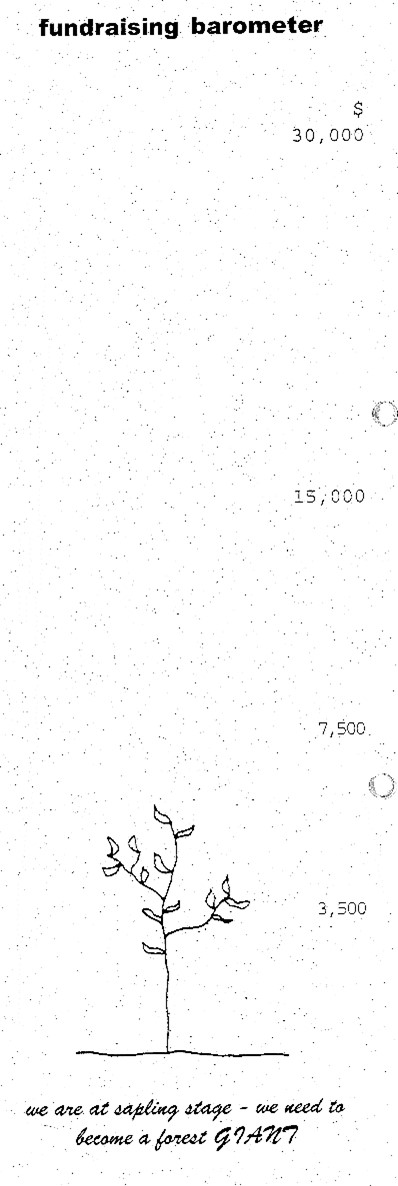
The party’s first Green Issue (Feb, 1990, p4) announced that an ‘effective electoral campaign’ required ‘at least $100,000. To date we have raised $3,358 in membership dues and $2,365 in donations’. Fortunately, the election of Jo Vallentine meant the Australian Electoral Commission reimbursed the Greens (WA) between $80,000 and $90,000. And so it went more or less from then on, with federal campaigns returning a ‘profit’ which subsidised state campaigns, in which government reimbursement is less generous.
In this regard, the 2009 by-election campaign which elected Adele Carles as the only ever lower house Greens member in WA was unusual. The campaign raised $75,000 from ‘a steady stream of donations’ supporting professional design of newspaper ads, flyers and leaflets, use of direct mail for the first time, an office rented for meetings, training, storage, establishing a solid visual presence, and ‘hosting Friday night drinks (very important for keeping up morale) and one very packed election night party!’ On polling day ‘Green flags and balloons float[ed] cheekily above the posters of the other parties’ (GI, Jun, 2009, pp1,7).
More challenging than financing election campaigns, is convincing a sufficient number of Greens members and supporters to make regular contributions for rent, wages, and the incidental costs of running an office. A pledge system predating Greenscheme secured 10 members pledging between $50 and $20 a month in 1992 (GI, Sep, 1992, p11). Over the years, urgent calls were made for pledges to pay the rent or the office manager’s salary, almost always yielding disappointment, for example the fundraising campaign in 2000 (see image).
Greenscheme, a regular fortnightly or monthly deduction in lieu of membership fees, is our second major source of regular income after tithes paid by our politicians. Sustaining this income requires regular telephone campaigns to members.
Between 1998 when Dee Margetts lost her senate seat and 2004 when Rachel Siewert was elected, Greens (WA) had no senators. At the 2005 state election, Greens Legislative Councillors were reduced in number from five to two, another significant loss in income, only partially clawed back with the election of four MLCs in the 2008 State election. The May Reps meeting in 2005 saw ‘mass resignations’ over the looming budget deficit and Reps’ failure to adopt a proposed budget charting a way out of the crisis. Co-convenors Paul Davies and Corinne Glenn, Treasurer Diedre Timms and Administration Working Group member Sonja Lundie-Jenkins all resigned. The new interim co-convenors applauded them for weathering two election campaigns and dedicating ‘an extraordinary amount of their time and their vast experience … to getting us through a testing time and we thank them profusely’ (GI, Jun, 2005, p4).
Greens (WA)’s need for funds is never met, as indicated by the emails we all receive asking us to donate, participate in fundraisers, become Greenscheme members or regular donors. Some members argue GWA should go into debt to run bold brave election campaigns, betting the house on electing more members or securing more first preference votes. On the whole, however, Treasurers and Representatives Council have adhered to their fiduciary duty and maintained financial prudence.
Conclusion
In our origin story, Greens (WA)’s roots in the peace and nonviolence movement make us excellent at ‘doing politics differently’. While we were the last to join the Australian Greens, we were the first to elect a Greens senator to the Australian parliament and to own our own premises, events book-ending our 30-year history. We also like to claim we ‘punch above our weight’, with more senators and upper house state representatives than many other states.
Of course we do not rest on our laurels, working to spread the practice of good consensus decision-making among our convenors and members, to build interesting innovations into Regional Group meetings, to find new ways to oil the frictions in a grassroots democratic machine as it becomes larger, more diverse and increasingly complex.
Ultimately, our fundamental question is how do we grow our vote from around a stubborn 10 per cent to secure enough seats to hold the balance of power, and then to work as the real opposition we claim to be, and finally to take government? How do we do that before the planet fries?
Header photo: Greens foundation members at the 30th anniversary celebration on 12th December 2020. #MilesTweediePhotography
